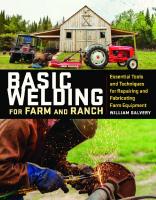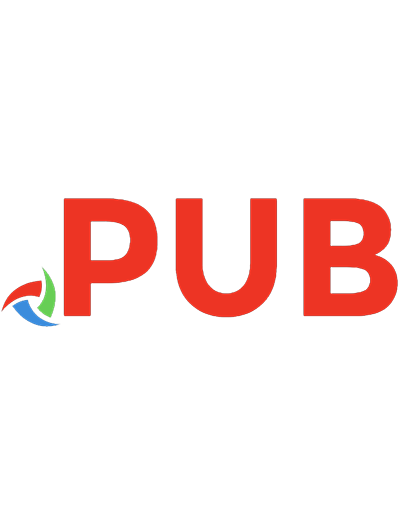Farm shop and equipment [Rev ed.]
624 86 2MB
English Pages 16 [17] Year 1953
Polecaj historie
Citation preview
&rm
Shoe and Eauipment
by: Delbert P. Schwab, revisor Published by: Cumberland General Store Route 3, Box 479 Crossville, TN 38555 USA Paper copies are $ 1.50. Available from: Cumberland General Store Route 3, Box 479 Crossville. TN 38555 USA
Reproduction of this microfiche document in any form is subject to the same restrictions as those of the original document.
Revised
by
EELBERT P. SCHWAB
-Farm machinery js important to self.-s:~ffi~ir~r.(.v. ERective care and repair of fam machinery requires an organized farm shop. as well equipped as pussitAe. to supplemrl:t~ the \vork of repair shops:, blacksmiths, etc. Every farmer has about the place an assortment of tools. It is no\v more important than ever before that he should carefully get this assortment together, put it in good shape fur service and keep it in such manner that 1o.d or misl~lawti items \vill show up at once. This publication offers suggested assortment of tools, special tools. and how to keep and care for them.
The purpose of the farm shop is to provide a drv. well-lighted .~hel~cr for small tcxils used in the necessary construction and repair \vurk \I!1 the farn:. antI a comfortable, conveniently arranged work room in xvhich some of this work may be done. This is a mechanical age in farming; nearly every kind of farm \vork is being done \vith the aid of son 2 mechanical labor-saving devict:. I*‘arm buildinx.s are subject to Deterioration and mechanical indur::. anti XII machinery will in time wear out or get broken. Theret‘~lrt~.a considerable amount of repair work is necessary, and every i‘arltier tlatjs more or !e,ss of this repair work himself. IMPORTANCE
OF FARM
SHOP
11 is impossible to estimate in dollars the value of a good farm >hol~ that is properly equipped and attended. Reliable sources esti:n:iie iin annua! saving of S5.47 per each $100.00 of investment in farm machinery alone, where the farmer makes all minor repairs and adjustments. This annual saving, on a farm equipped with $2,000 worth of machinery, would pay for the shop equipment kvithin 4 to 6 years. dicatlon of the increasing need for good farm shops is the increasing use of tractors and other power equipment in farming. In 1945, the Census shows there were over 24,000 tractors on Tennessee farms, while in 1950 the tractor population exceeds 55,000. There has been a corresponding increase in many other items of equipment found Fig. L~~Machi”er,shed. on the farm. It tvill be more profitable in the future if repairs and depreciation on this expensive farm equipment can be kept to a minimum by systematic home repair and maintenance made possible by the possession of a farm shop equipped with the proper tools to make repairs quickly and at a reasonable cost. LABOR
ANB
MONEY
SAVING
ADVANTAGES
To .Qummarize, the farmer who has the ability and actually does his .jiml)ltr farm shop work saves: 1. in cash outlay. 2. Valuable time by doing repair work in shop during rainy or bad weather. 3. By doing emergency shop work during rush seasons. 4. By adjusting or adapting tools and equipment to fit the farm needs. 5. By making certain tools, appliances, or conveniences that may )~e needed and otherwise are not available.
3
6.
By eliminating travel and expense of taking from the farm to be done. WiiAT
W3RK
SHOULD
BE DONE
IN THE
FARM
shop work away SHOP?
.JI‘i-li!e some farmers fmd a welder an excellent addition Taotheir farm shop, most farmers do not find it advisable to attempt the more plowshares, iathe difficult shop jobs, such as welding, sharpening work. and cabinet work. for one of two reasons: either they lack the ability to do the job properly, or there is not bnough such work to justify the investment that would be necessary for tools. A large amount of farm equipment is now built on the precision principles followed in the manufacturing of an automobile and it would scarcely be worth while for a farmer to attempt to keep a shop adequately equipped to do major overhaul jobs ?n such machinery. However, there is such a difference between the hourly farm wage and the hourly mechanic’s wage, that a farmer cannot afford to have mechanics do many of the simpler repair jobs. Therefore, a i modest equipped to .do . repair . . shop . .. . A9 rnese simpler ~00s woula De most de- Fig. 2--Floor Plan for Shop in End of Machinerr sirable. A repair shop equipped for shed. (se YOY~ COU~W Agentfor COIWM~ PISII. No. 5696, which contains bill of material and the complex major overhaul jobs would not be advisable unless the simi’ararra”peme”t.’ farmer has the mechanical inclination and can do repair work for his neighbors as well as his own, thus justifying the expenditure for the necessary equipment. Each individual must use his own judgment as to whether it is best to attempt the more difficult shop jobs himself or to hire them done; but in the case of the more ordinary repair and construction jobs there is little choice. The farmer must usually do these jobs himself or they will not be done. COMMON
TYPES
OF SHOP WORK
The kind of shopwork to be done must be definitely in mind if one is to decide intelligently on the design of the shop building and select the list of tools and materials to be purchased. The following list is not complete, but is representative of the kinds of shopwork done profitably by farmers. Woodwork. Construction of small buildings, and equipment, such as poultry houses, nests, feed bins, troughs, self-feeders, gates and hayracks, building forms for concrete work, removing rotted or broken parts of buildings and fitting new pieces, making and fitting new tongues, double-trees and other wood parts on implements, and fitting new handles in hand tools. Ironwork. Simple jobs in forging, such as cutting, bending, and shaping braces, drilling, thread cutting, removing worn and broken parts from implements and replacing them with new parts, making
4
adjustments to take up wear, and making adjustments in the field for different working conditions. Building foundations, floors, walks, tanks, Concrete Work. troughs. posts and the like. Setting posts, fitting braces and gates, stretching and Fencing,. fastening w1ro. ‘lectrical Appliances, Automobiles, Trucks, and TracRepair ( bearings and other parts to take up wear, grinding tors. Adjust \al\‘es. replacing worn parts and making other minor repairs and adjustments. The emergency repair of plows, Repair of Field Machinery. planters, binders, mowers, combines, and other farm machinery, and the occasional complete overhauling of this equipment. !?t’i;ellWork. Pulling and repairing pipes and rods and replacing worn leathers and valves in cylinders. Pipe Fitting. Installation of water pipes (mostly y&inch, Qinch, I-inch sizes). Soldering. Repair of tinware, gutters and downspouts, and electric wiring. Babbitting. Rebabbitting bearings on machinery. Relating or fastening belts for power machinery. Belt Lacing. Ropework. Rope splicing and knot tying. Harness Work. Cleaning and oiling, sewing and riveting new parts, and replacing hame staples. Every moving part of machinery should be amply Lubrication. supplied with the correct kind and grade of lubrictint. Painting. Painting small buildings, equipment and implements, coating plow moldboards and other bright parts with heavy oil, varnish, or paint to prevent rust, and boiling wood wheels in linseed oil. Sharpening mower knives, axes, saws, chisels, Tool Sharpening. drill bits, and other tools. Or removing horse shoes and trimming hoofs to Norse Shoeing. prevent injury until shoeing’ can conveniently be done. DESIRABLE
FEATURES
IN A FARM
SHOP
Shelter space sufficient to work on any one machine. Protection from rain, from cold, ventilation from heat nnd smoke. 3. Good natural and artificial lighting. 4. Concrete or packed earth floor. 5. Wall space, cupboards, or drawers for tools. (Fig. 4) 6. Shelves, racks, bins, for parts, bolts, nails, etc. 7. Source of power for grinding, sawing, drilling, etc. 8. Space around every power tool to permit work on big pieces. 9. A central and convenient location. Farms employing four or more head of work stock shouid consider the plan shown in Figs. 1 and 2 a minimum for their needs. For smaller farms, space in an existing building, providing safety from .:parks and forge fires, can be used. It should contain bench, vise, anvil, tool grinder and such other equipment as space permits. 1. 2.
5 MINIMUM
EQUIPMENT
AND
TOOL
ARRANGEMENT
First essentials are: vise and effective set of hand tools.
FitI 3-Aftrr the shop huilcline or spslcc h;,r bwn rm,Vit,Ct,. the first essentiai is a goul work beech.
Fie. 4 This arranwment ~“c”“raCES :ng hand tOOk in orit. cwoiral ,rrind of ten days to rwo we+ks while !h .e::lpty :a.nks are being re-charger! or refilled. For most,, ihe long!erm :L.XX is the most desirable arrangement. Ele oxg-acetylene welder is particularivaluable as a tool to braze tir brorze-weld and to cut s,trel and iron. Where a person has su&:it!nt Fvork to ,justif:; both arc and oxg-acetylene welders, each welder complements the other. For the average farmer who can ,justi:- only one welder, the electric arc welder is always ready to use, economica: to operate, and can be tised for neariy everv type of we!dmn needed on the farm. A welder is usuallv a sound investment on Z’arms lvhere there is a considerable investment in machinery, as many broken parts can be repaired on the farm rather than a time-taking trip into town to a garage.
Possibly the most essential farm shop equipment-and important as the vise and drill-is the grinding equipment.
equally
one tspe of Frindstone is shown in FIG. 9, litable for lilw tui”di”yi. Anuther. FiE II. suitable for a variety of td ~rintling jobs. he rrindrr ill Fia. 12 Will do all nrindi”: wk. irum the finr t”“ls t” ,110” .shnres.I”,, “IVPlsickleu.
Fig. 9--A rood and inex*ensiw electric r:rinder with teal grindinn UhCPI,sickle grimier. anIl disk holder eQuipme”t, ‘DUI!Pd h? 2 port?.L4e farm eirctrie motor.
It must be remembered that large grinding wheels cannot be driven at high speeds; the most satisfactory, safe speed for grinding wheels from 4” to 16” is indicated in table below. -, Dlomefw inches
of
Wheel
Surfoc. sp.afJ 0, ,000 1.d
l”rfar* speed sf 1mo hat
R.P.M.
R.P.M.
4 ................................................ 3,820 4,775 5 ............. ..................... .......... 3,056 3,820 6....~ ........................................... 2,546 7 ................................................ 2,183 2,728 a ................................................ 1,910 2.387 10 ................................................ 1,910 1,528 12.......~ ...................................... 1,592 1,273 14..~ ............................................ 1,09 1,364 16............................................... 955 1,194 --
surflaw *“setI u, mofl f.., R.P.M.
I5,730 4,584 3,820 3,274 2,865 2,292 1,910 1,637 1,432
8
“SNAP-ON” SOCKET WRENCHES
SOLDERING IRON SCENT
SINGLE
END
TINNERS’
SOLID
BOLT CUTTEB
STEEL
WIRE
SNIPS
DRIVE
PUNCH
ALIGNING
SCRATCH
iSEE LIST C TOOL
“C” CLAMP
1/4
-
3/8
-
I&?
-
PIPE WRENCHES STILLSON
PATTERN
FLATFILE
RIVET
R DRIFT
SET-
PUNCH
DUALPURPCEE PUNCH
ITHER SUGGESTED IN PAGE 14)
S/8
-
314
The next essential
in a farm shop is drilling
Fix io--A n,cct slti5f8rtor? ,,,iiii”C C.!“ip. mrnc is the “i‘W!$P dlii!, Chiih “U can be cut “Ore ecmbf
li \~A~Cld by Cl”” pro:ess. Threcds 0”d torges easy.
b” any pro;;rYeId :ess. Holds thread
steel;
05 cast
will
UOil.can be heat?, and re-shaped >‘ forged IlOWlY. remper carefully. Welds by any pm:e55. OXd”lly. CO” be re-ternPeed. but not too Dire”. con forge ilowly. Holds ttlreo* well.
I I
Same OS CO%+ steel; b “t torge and +emcKYmore C.Xef”lly.
break.
I
I
Weld
ten. ‘owe
b” any
llro-
Shop.2 or eel”. Con-
c.oi be tempered.
Same OS cold roll hut may temper *lightly.
c h e a p e r +o replace than repair. ctIeop to repLace 5nm11 tw.Tings.
colol-eosilY
-




![Farm equipment and hand tools a practical manual [Reprint of the 1887 ed. New York, Judd]
9780828903561, 0828903565](https://dokumen.pub/img/200x200/farm-equipment-and-hand-tools-a-practical-manual-reprint-of-the-1887-ed-new-york-judd-9780828903561-0828903565.jpg)





![Farm shop and equipment [Rev ed.]](https://dokumen.pub/img/200x200/farm-shop-and-equipment-revnbsped.jpg)